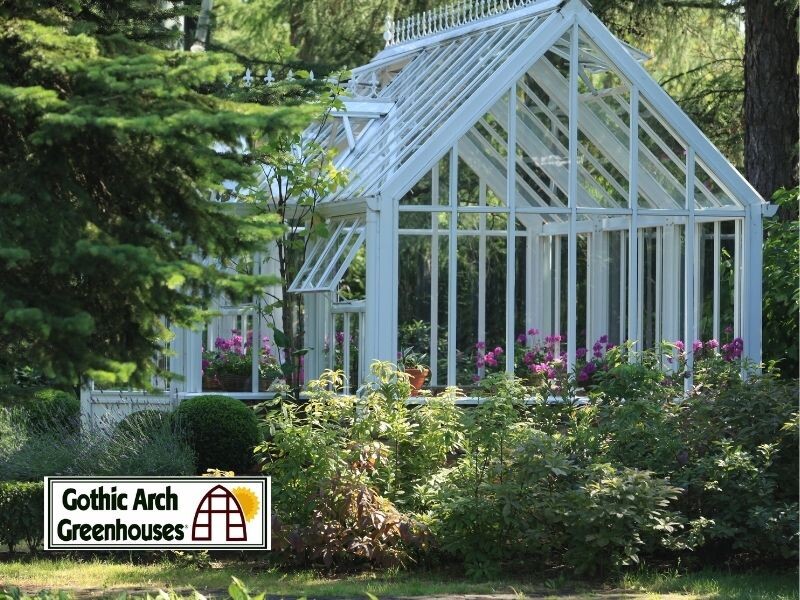
Written by H & B . Sierke (Gothic Arch Greenhouses INC.)
As the colder months approach, it's essential to winterize your greenhouse to maintain optimal growing conditions for your plants. Heat retention becomes a top priority, as protecting plants from chilly temperatures is crucial for their survival and continued growth. This blog post will provide essential tips and strategies for effectively winterizing your greenhouse and maximizing heat retention. From insulation and ventilation to thermal covers and heating systems, learn how to create a cozy and nurturing environment for your plants throughout winter.
Insulate Your Greenhouse: Insulating your greenhouse is vital for retaining heat and protecting plants from extreme cold. Consider insulating the walls, roof, and even the floor if possible. Use materials like bubble wrap, foam insulation, or insulating blankets to cover the interior surfaces. Sealing gaps or cracks with weather-stripping or caulk can prevent drafts and heat loss.
Optimize Ventilation: Although heat retention is crucial, proper ventilation is equally important to prevent excessive humidity and condensation buildup. Maintain adequate airflow by installing adjustable vents or louvers. Automated vent openers can help regulate temperature and moisture, ensuring a healthy plant environment. Balancing heat retention with proper ventilation will create an optimal growing environment.
Utilize Thermal Covers: Thermal covers, such as thermal blankets or horticultural fleece, provide additional insulation and protection during cold weather. Cover susceptible plants during nights or colder periods to shield them from freezing temperatures. These covers help trap heat and create a microclimate around your plants, preserving warmth and preventing frost damage.
Implement Heating Systems: To ensure consistent warmth during frigid winter nights, consider implementing a heating system in your greenhouse. Options include electric, propane, radiant, or geothermal heaters. Choose a heating system appropriate for your greenhouse size and the specific needs of your plants. Position heaters strategically to distribute heat evenly and avoid overheating or drying your plants.
Monitor and Adjust: Regularly monitor your greenhouse's temperature and humidity levels using a thermometer and hygrometer. Adjust the heating and ventilation settings accordingly to maintain a stable and favorable environment for your plants. Different plant varieties may have specific temperature requirements, so be mindful of their needs.
Cold-Tolerant Plant Selection: Consider growing cold-tolerant plant varieties that can withstand lower temperatures without extensive heat retention measures. Cold-hardy vegetables, herbs, and flowers can thrive in colder conditions, requiring less heating and insulation. Research suitable cold-tolerant plants for your region and include them in your winter greenhouse gardening plans.
Who’s ready for some winter gardening? As calmer temperatures approach, many growers aim to keep their plants alive through harsher conditions. However, with careful planning, energy-saving tactics, and a few products you may already have, you can have a thriving winter greenhouse this year!
Many gardeners are now packing away their shade cloth until warmer weather is near. Letting every last bit of the weakening sunshine into their greenhouse or winter garden is foremost in most growers’ minds, so why keep your shade cloth in place? Depending on your shade cloth, it can be a thermal heat curtain in winter. That’s a big plus for keeping valuable heat inside your growing space!
Aluminet shade cloth is excellent at keeping the heat your greenhouse has collected from the sun during the daytime inside at night. Hung inside your greenhouse, the aluminum filament preserves heat and can increase the efficiency of your heater by up to 30%! Many growers will open or remove the shade during sunny days and close it at night. This method makes the most available sunlight during the day and helps trap the heat inside when the evening comes.
Aluminet also successfully reflects the invisible heat radiation from plants and the greenhouse floor. This heat energy gathers during the day and is released at night in all objects. Traditional black or colored shade cloth can also slow this heat loss but is less effective than Aluminet in reflecting this heat to the plant's leaves.
Shorter days and less light may mean that you want to add supplemental lighting to your greenhouse. If you don’t already have growing lamps, heat output is a special consideration for winter. While very cost-effective, LED lighting can be expensive to invest in and produces very little heat. During winter, metal halide (MH), high-intensity fluorescent (HIF), and high-pressure sodium (HPS) are good choices due to the heat they produce, as well as the low cost to implement. You can read more about how to choose the best greenhouse lighting here:
Aluminet is also helpful in increasing the benefits of your lighting. The twisted woven strands of Aluminet reflect diffused light in many directions from the source. This diffusion and reflection promote more vigorous growth in the lower branches, less stress on the leaves, and more even light distribution.
With the addition of a specialized heat-retention curtain, your supplemental lighting and heating can also be more effectively used in your greenhouse. A closed fabric for efficient heat retention made from woven polyethylene and aluminum strips can be an excellent investment for winterizing your greenhouse. In addition to moderating daytime and nighttime temperatures, these curtains reduce shadows, control air movement and cold spots, and add optimum light diffusion to your indoor crops. Call our experts today for a quote on this new and innovative item!
A natural way to lower your heating costs is by storing heat. Use planters filled with soil or even large containers of water. Both options store heat, providing even more ways to seal in warmer temperatures inside your greenhouse. Moving raised beds inside is a great way to grow and store your warmth all through the coldest part of the year. It’s a great time to switch to winter-specific crops requiring less sunlight! We have several blogs regarding winter crops, which
